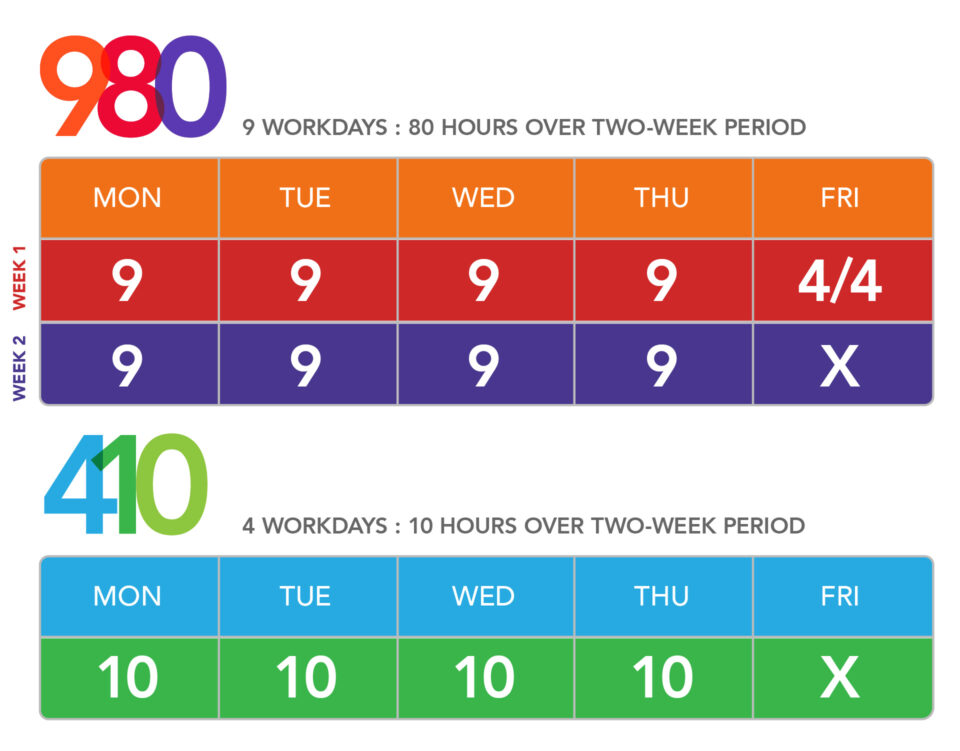The 9/80 Schedule: Benefits, Drawbacks, And More
Try When I Work for free
What if you could tell your employees they get an extra two days off each month?
Not vacation days. Not counting weekends. No loss of hours. Two genuine three-day weekends each month while still hitting full-time hours.
With a traditional 9-to-5 work schedule, that’s not going to happen. Even with staggered and alternating shift work, it’s tough to promise two extra days to your employees. While there’s no end to how you slice and dice the work schedule, alternative workweeks continue to gain in popularity. The 9/80 work schedule is an approach that’s getting some buzz online.
Because two extra days off.
Maybe you’re not familiar with the 9/80 work schedule, or you’re not sure it’s something that’ll work for your business. We’ll give you an overview and give you the information to decide if it’s right for you.
Key takeaways
- The 9/80 schedule means that your employees would work 80 hours in nine days, over two weeks
- It’s a great way to attract new talent because it offers excellent work-life balance with an extra day off
- The 9/80 work schedule can also increase productivity in your current employees because they get more time to rest and recharge, while only adding an hour to each workday
- You need to vigilant about overtime because it’s easy to let it get away from you when your team is working over eight hours most days
- Time-off requests and paid holidays can get confusing as well, so be sure to have clear policies
Did you know that there’s software designed to automate the employee scheduling process? Try When I Work free for 14 days to see how you can get started with the 9/80 work schedule easily.
How does a 9/80 schedule work?
A 9/80 work schedule covers a two-week work period, where a total of eight days have nine hours, one day has eight hours, and one day is off.
It’s not as confusing as it sounds. Let’s use an example work schedule.

The first week, an employee would work Monday through Thursday for nine hours. On Friday, they’d work four hours, go to lunch, and then work another four hours. The following Monday through Thursday would be nine-hour days, while Friday they would have off.
Every other week, employees get a day off. The work schedule could be staggered among groups of employees to provide full coverage every week if necessary.
There’s flexibility in the start and stop times, of course. Payroll sees the end of the workweek when the employee goes to lunch on Friday. The start of the next work week is when they come back.
We should note that because some days are nine hours and some are eight, paid time off, sick leave, and holidays can be tricky. We’ll cover that in a bit.
Should your business try the 9/80 shift system?
While some businesses and employees swear by the 9/80 work schedule, it isn’t a good fit for every business. It’s important to know the benefits and the drawbacks before making serious changes to how you structure your work week.
Benefits of the 9/80 work schedule.
There are several benefits to the 9/80 work schedule:
- Attract new hires. In a tight labor market, you’re always looking for new benefits that would attract new employees, but you also have to be mindful of your bottom line. The 9/80 work schedule costs you nothing while allowing you to promote a great work-life balance for your employees.
- Better commutes for employees. Because your work hours aren’t the same as everyone else’s hours, your employees’ commutes will be better. They won’t be on the road when the rest of the cars are.
- Increased productivity. The longer hours allow employees to get more done not just because they have more time to work with, but because they can do a deep dive and not have their focus interrupted from a work day that ends sooner.
- Better rest. Your employees are getting a three-day weekend twice a month, and that gives them a chance to rest and be refreshed when they come back.
Start your free 14-day trial of When I Work! Click here to start scheduling your employees today.

Drawbacks of the 9/80 work schedule.
There are complexities to the 9/80 work schedule because of the longer hours of most days with less hours on some days, which can create problems:
- Overtime can get away from you. Because the workweek is structured differently, you’ll have to stay on top of employees as far as when they’re taking their lunch, or if they’re coming in or leaving earlier or later than they should. It’s very easy to trigger overtime simply by taking a late lunch on the split Friday, for example, or leaving later in the afternoon one of those days.
- Paid time off requests are tricky. You’re dealing with a mix of nine-hour days and eight-hour days. Holidays that fall on nine-hour days would be marked as eight hours holiday, one hour vacation. Some employees might not like a holiday eating up a vacation hour. There are similar issues with sick leave depending on whether they took the eight or nine hour day. When employees request PTO on a day that isn’t their scheduled day off, it can make tracking hours difficult and quickly lead to overtime issues. If you aren’t using an automated time tracking system in this instance, using a spreadsheet for employee time tracking can be extremely challenging.
- Traditional hours clash. If you have independent contractors, freelancers, or employees working from home who are using a more traditional work schedule, the schedule might frustrate them if they’re working hours and need to communicate with employees who aren’t at work. Plus, this schedule might also frustrate customers and other businesses using traditional work schedules if you’re not open when they need you, while your employees will work a few hours nearly each day where other businesses aren’t open yet.
- Small businesses might struggle for coverage. The 9/80 work schedule functions best with larger organizations. You might have staffing gaps if your workforce is small and there are people missing an extra two days a month.
Using a scheduling software like When I Work can help you with these issues. You’ll be able to build templates that ensure coverage and help you keep a close eye on labor costs. Plus, it’s easier to manage time-off requests and employee availability right within the schedule.
How to implement a 9/80 work schedule
If you’ve run the numbers and you’re convinced the 9/80 work schedule is best for your business, there are few steps to start.
- Consider if it will affect your employees. Will all of your employees be on the 9/80 schedule, or will you keep a unit of employees (e.g. customer-facing employees) on a traditional schedule?
- Create sample schedules. Before upending your actual work schedule, you need to do some dry runs to make sure it works on paper. Get past schedules to work from and try several versions of how a 9/80 work schedule would fit what you need. How does it work with shifts? Is there enough coverage for customer demands? Are you able to manage this complicated employee schedule with your current time tracking and scheduling software?
- Talk to your employees. The last thing you want to do is drop a huge schedule change in their lap. Unannounced schedules can have an impact on how sick leave and vacation time will be calculated. Not everyone will like the 9/80 approach, and you want to get some feedback on how you’d implement it. You may discover some valid employee concerns you hadn’t thought of that would affect how or what you do.
- Create a feedback loop. This is a major change for everyone. Make feedback easy (and free from repercussions) in both directions as people adjust to this new schedule. You will have to monitor the hours carefully in the beginning, especially, due to the overtime issue. But you also want to hear from employees about what’s working and what isn’t.
When I Work can help you manage all of these ideas. You can build templates out to make sure your schedule works before you implement it. Plus, you can use team messaging to see what your team thinks of the schedule before and after you start using it.
If there was ever a time to make the leap to an automated scheduling and time tracking solution, this is it.
Managing the 9/80 schedule manually, particularly if you have lots of employees or are staggering the workweeks for coverage, will be almost impossible. You’ll definitely run into overtime trouble and make mistakes with time-off requests that will frustrate everyone.
When I Work can help you get started with the 9/80 schedule
When I Work makes creating employee schedules—including alternate versions like 9/80—much faster and easier. You can automate schedule creation, defining it only once instead of each pay period. Our time clock app integrates with the scheduling system, making it more accurate at tracking overtime and other work data on your at-a-glance dashboard.
Whatever scheduling system you decide to use, know that alternative work schedules like 9/80 might be just what you need to attract new employees in a tight labor market.
Sign up for your free trial of When I Work today to get started with the 9/80 work schedule at your business.






